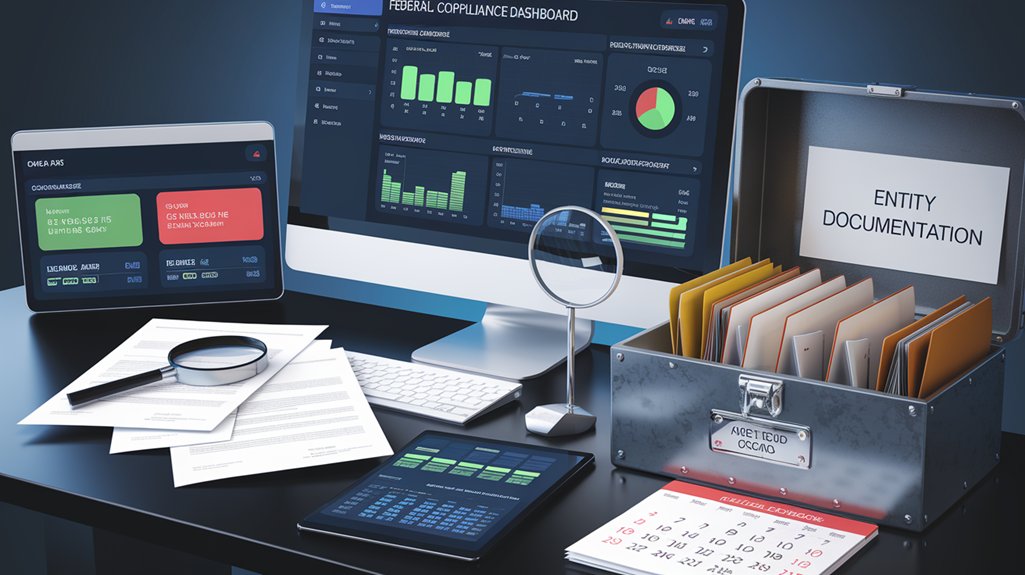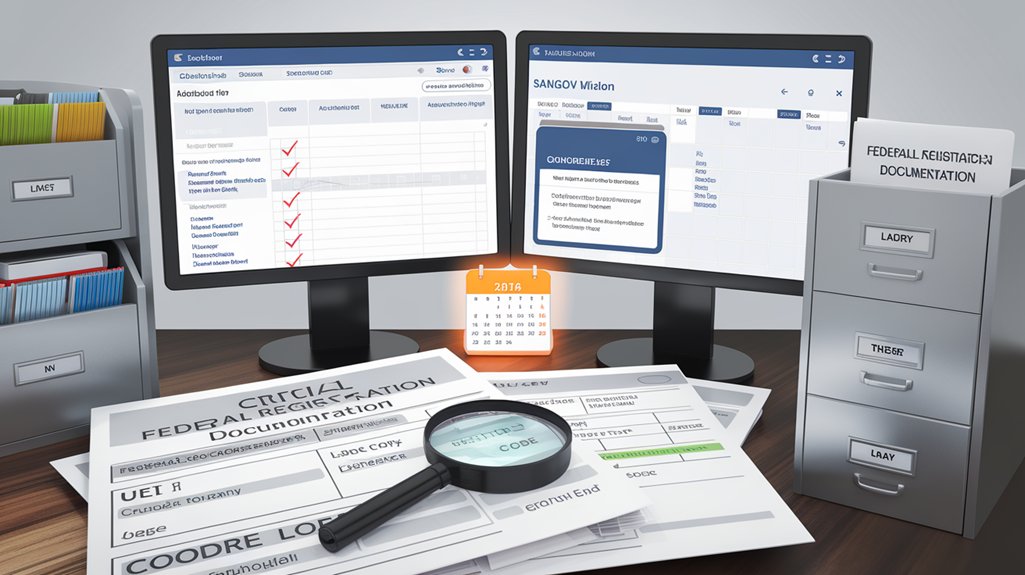Federal contractors must regularly verify UEI (12 alphanumeric characters) and CAGE code (5 alphanumeric characters) accuracy in SAM.gov to maintain compliance. Best practices include monthly account reviews, quarterly TIN verification, and tracking CAGE renewal dates. Establishing internal audit processes and documentation templates prevents registration errors that could jeopardize contract eligibility. Creating compliance checklists and notification systems guarantees timely updates and reduces validation issues. Proper maintenance strategies protect contractors’ standing with federal agencies.
Essential Differences Between UEI and CAGE Identifiers

While both serve as identification systems in government contracting, UEI and CAGE codes differ markedly in their structure, purpose, and administrative oversight.
The UEI, consisting of 12 alphanumeric characters, is administered by SAM and offers universal application across all federal contracting opportunities—one of the primary UEI advantages.
The UEI’s 12-character format offers comprehensive identification across federal contracts—a significant advantage in government procurement processes.
In contrast, CAGE codes contain five alphanumeric characters and are managed by the Defense Logistics Agency, focusing primarily on defense contracts.
The UEI’s broader application represents significant progress in streamlining government contracting, replacing the previously used DUNS number system. This transition in April 2022 was implemented to establish a free registration process that eliminates the costs previously associated with obtaining identifiers for federal contracts.
CAGE limitations include its narrower focus on defense and NATO-related contracts, making it less versatile for entities pursuing diverse federal opportunities. Active account maintenance is crucial for maintaining compliance and accessing government contracting opportunities.
Both identifiers, however, remain essential for proper entity verification within their respective domains of government procurement. Registration with SAM.gov is mandatory for entities seeking to do business with the federal government and obtain both identifiers.
Critical Steps for Maintaining Accurate Entity Data

Maintaining accurate entity data represents a fundamental requirement for government contractors once they have secured their identification credentials.
Federal regulation compliance requires diligent oversight to maintain eligibility for government contracts and funding opportunities.
Regular entity verification prevents compliance issues and protects contract eligibility through systematic data review processes.
Effective compliance strategies include:
- Conducting monthly SAM account reviews with particular attention to core data elements
- Verifying UEI accuracy and TIN information quarterly
- Tracking CAGE code renewal dates, remembering the five-year renewal requirement
- Guaranteeing all supporting documentation remains current, including Articles of Incorporation and IRS letters
- Creating a compliance checklist for regular monitoring of key identifiers
Organizations should establish notification systems for impending renewal deadlines and maintain a designated point person responsible for entity data management to guarantee continuous compliance with federal requirements. Utilizing compliance tools for validation can significantly improve the accuracy of business information during the regular review process. Physical address validation is crucial as short-term locations and PO boxes are not acceptable for SAM registration.
Mitigating Risks of Registration Errors in Federal Systems

Maneuvering federal registration systems requires meticulous attention to detail to avoid potentially costly errors. Organizations must implement registration best practices and establish systematic validation procedures to maintain accurate entity data in SAM.gov and related federal systems.
- Conduct quarterly internal audits of registration information against official documentation to identify discrepancies before renewal deadlines.
- Develop thorough compliance training programs for staff responsible for managing federal registrations.
- Create standardized documentation templates that align precisely with validation requirements for both UEI and CAGE code maintenance.
Businesses operating in co-working spaces should secure proper utility bill documentation to overcome the new physical address verification challenges imposed by the DLA.
Many organizations have found success by creating dedicated compliance teams responsible for entity validation oversight.
Regular updates ensure grant review success when federal agencies evaluate organizational profiles for funding opportunities.
These teams can monitor regulatory changes, maintain documentation libraries, and guarantee that all submitted information matches exactly with official records, preventing delays in processing and maintaining eligibility for federal opportunities.
Setting calendar reminders 2-3 months in advance of expiration dates ensures adequate time for addressing any validation issues that might arise during the renewal process.
Frequently Asked Questions
How Long Does Initial UEI Validation Typically Take?
The initial validation timeline for UEI registration typically spans 10-15 business days from submission to completion.
This process includes approximately 10 days for registration activation and 3-5 days for verification.
Processing delays commonly occur when documentation is incomplete or information discrepancies are detected.
The system follows standard stages: application submission, system review, validation, identifier assignment, and final approval.
Businesses should prepare documentation thoroughly and monitor communications from SAM.gov to guarantee timely completion.
Can Subcontractors Use Prime Contractors’ UEI or CAGE Codes?
No, subcontractors cannot use prime contractors’ UEI or CAGE codes. This practice violates federal contracting regulations and misrepresents the entity performing the work.
Subcontractor responsibilities include obtaining their own unique identifiers through SAM registration. Proper code usage guarantees accurate reporting of subcontracting dollars, maintains data integrity in government databases, and supports compliance requirements.
Using another entity’s codes can result in contract non-compliance, potential legal penalties, and disqualification from future government opportunities.
What Happens if My Business Relocates During Active Contracts?
When a business relocates during active contracts, several key actions must be taken.
The company must update its address in SAM registration, though the UEI remains unchanged. The CAGE code may change if moving to a different region.
Contract modifications will be necessary to reflect the new location.
Businesses should review existing agreements for address update requirements and notify contracting officers promptly to maintain compliance and guarantee uninterrupted performance of contractual obligations.
Are UEI and CAGE Code Requirements Different for Nonprofit Organizations?
Nonprofit organizations follow the same basic UEI and CAGE code requirements as for-profit entities, but with distinct nonprofit eligibility considerations.
Nonprofits must provide their IRS tax-exempt documentation during SAM.gov registration. The tax implications differ, as nonprofits use their EIN rather than SSN for registration purposes.
While both entity types need annual SAM renewal, nonprofits should guarantee their tax-exempt status remains current to maintain proper registration and eligibility for federal funding opportunities.
How Do Mergers and Acquisitions Affect Existing UEI and CAGE Registrations?
Mergers and acquisitions have significant implications for UEI and CAGE registrations.
When ownership changes through merger or acquisition processes, the existing CAGE code typically cannot transfer to the new entity. The acquiring company must obtain a new CAGE code when assuming responsibility for contracts.
Similarly, a new UEI is required for the newly formed legal entity. Companies must update SAM.gov registration information promptly after acquisition to maintain federal contracting eligibility.